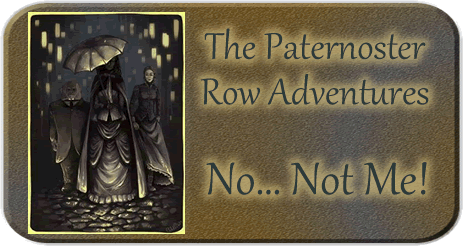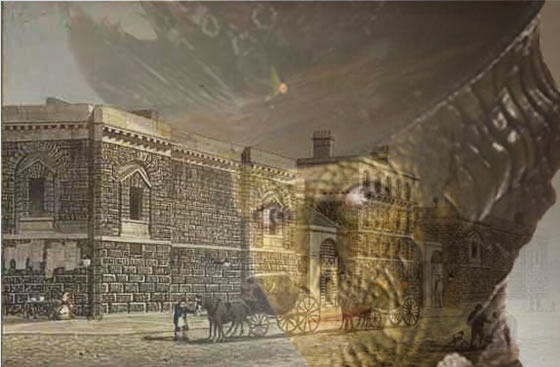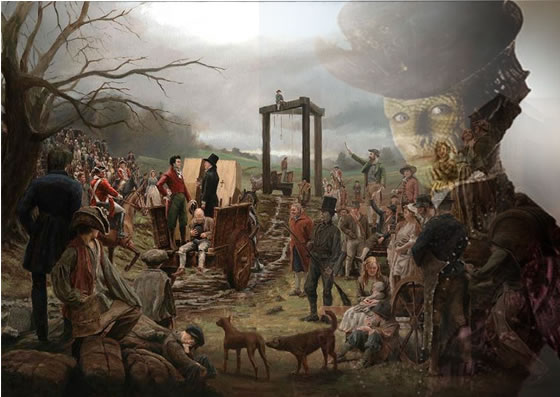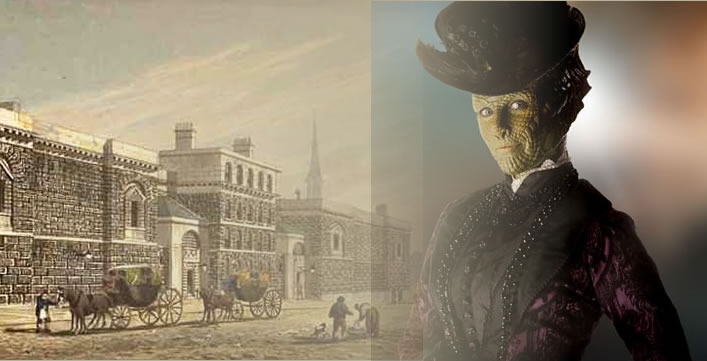

Madame Vastra came into the hallway to be met by Jenny, who kissed her fondly on the cheek, a thoroughly decorous indication of their privately more decadent love for each other.
“I thought you would be home sooner,” Jenny said as her lover divested herself of hat and coat. “It WAS just a hanging. At eight o’clock in the morning, as usual, wasn’t it?” Madame was on a committee of trusted visitors to Newgate prison, and often attended as a witness to hangings, some of then mundane, some of them notorious.
“It was, but I wanted to be certain of some aspects of the affair. Is lunch ready?”
“It is, now that you are home,” Jenny answered. “Millie is joining us. It is her afternoon off, but Michael can’t meet her until three – police business. I thought it would be an opportunity for the new maid, Ellen, to get used to serving.”
“Quite right,” Madame answered. She smiled to recall when Jenny had been her maid when she wasn’t being her lover. Then Millie had come to them, timid and uncertain, absolutely terrified of Strax. Now Miss Millicent Dawson, Millie only to her friends, with her diploma in household management, was designated as housekeeper and Jenny thought of her as a friend, not a servant.
Jenny herself had grown in status. She was much more assertive than she used to be. Deciding who might lunch with them was an example of how she felt herself joint mistress of the house in Paternoster Row where they all lived and prospered.
Millie was already in the drawing room, sitting next to the fireplace in her best going-out dress, her hat and coat ready to put on when her young man arrived. When Jenny and Madame Vastra came in, she moved to the table with them. Shortly after that, as if they had timed it exactly, Ellen, a pale-complexioned girl of fifteen, with blonde curls peeping out under her cap, carried a large and laden tray nervously while Joe followed her from the kitchen with a steaming teapot.
Lunch in respectable houses tended to be light. There might be boiled eggs, cheese, buttered bread, potted meats or slices of cold meat left over from the previous evening’s dinner. A cold pudding was also to be expected. Lemon meringue pie or a syllabub or blancmange. A bowl of fruit might also be set on the table.
Lunch at 13 Paternoster Row followed that pattern except that there was far more cold meat than on other dainty and refined luncheon tables. Madame didn’t care for boiled eggs or cheese and only ate a little bread and butter, but enjoyed a full plate of cold meat. In truth, she would happily eat it raw, but she knew her human friends would find that unpleasant, so she made do with thickly cut pieces of beef and pork.
When lunch was over, she turned to Jenny’s question about this morning’s hanging.
“It was her, wasn’t it,” Millie said. “Everyone is talking about it. Martha Ashe, the baby killer.”
“As many as fifty infants given into her care… smothered to death, and burnt in her furnace,” Jenny added.
“The papers say she actually cut parts of the flesh and cooked it to eat,” Millie continued. “She admitted to fried slices of ‘belly pork’. Uggh.”
Everyone looked at the remains of the meat platter and shook their heads. Even Madame decided not to have another portion.
“The papers are correct, despite the lurid and shocking way they reported it,” she said in a tone that suggested it was the final word on the subject. “She did unspeakable things, some far viler and more depraved than mere cannibalism.”
Millie and Jenny looked at Madame and wondered what could be viler and more depraved than cannibalism. Madam did not elucidate. Perhaps she wanted them to be able to eat there lunch tomorrow.
“I have seen the transcript of her confession,” she confirmed. “The papers, even the cheapest and most sensationalist ones, would not dare print the worst of it. Little wonder my people abhor humanity as a degraded species.”
Jenny didn’t remind Madame that she had once said that her people, in times of famine, ate their young to reduce the population. This WAS different in a way that intellectuals in universities might call the Malthusian principle, though Jenny wouldn’t have been aware of that. She just knew that this woman, Martha Ashe, had been evil and deserved her fate.
“Not all of us, surely?” Millie said after a small pause, another example of her new confidence in speaking to Madame.
“No, not all,” Madame admitted, giving Jenny a salacious look that Millie, for all her new sophistication, didn’t QUITE understand. “But when humans go bad, they do so in ways that none of my people would imagine possible. Martha Ashe, embodies that absolute, irredeemable evil. But ever since her trial, which I attended daily, as you know, I have had suspicions about the depths of that evil and just how long it has been going on before she was finally brought to the ultimate justice.”
“What do you mean?” Jenny asked. “Is it that she may have killed more than the fifty babies she was accused of?”
“No, it is far more complicated than that, and far more sinister. As I said, I have been investigating for the past four weeks – since the verdict and sentence was passed, when her attitude to such a terrible sentence – one that should dismay most people - gave me food for thought. I discovered a sequence of events, terrible, depravities, the last chapter of which took place this morning in the execution chamber at Newgate Prison.”
“When you witnessed her hanging,” Jennie asked. “Nobody escapes the long drop.”
She said that in a matter of fact way. Quite apart from Madame’s involvement, living so close to Newgate it was impossible to avoid knowing when executions were taking place. It was something she had learned to take for granted.
“Yes… I saw her hang. And the aftermath. But… if you want to know better, fetch a candle. We will do it as a ‘conference call. Then you, too, will be witnesses.”
Jenny and Millie both wondered why Madame called this strange hypnotic time travel a ‘conference call’ The two words together made no sense to them. But whatever it was called, Jenny had done it several times and Milie, once, when she had asked about the Great Exhibition of 1851, and Madame had arranged for her to visit, in spirit if not in body.
This ‘conference call’ was going to be far more serious.
“You both know, I suppose, the history of the Tyburn Tree?” Madame asked. “Never, of course an actual tree The first wooden gallows were built near whnat is now Marble Arch, only a very shortr walk from us, here, in the twelfth century.”

As the candle, suffused with a powerful soporific began to take effecr, both girls nodded. They had walked past Marble Arch many times and, as born and bred Londoners, they knew its history perfectly well. But having Madame recite the facts served to concentre their subconscious thoughts.
“The first witch to be convicted and hanged in London was taken to Tyburn in 1599. Her name was Anne Karke and she swore she was blameless of the crimes set against her. She even convinced the Bishop of London of her innocence. But the judge was not swayed and no reprieve was likely to be granted to a witch in those days.”
Almost]t as soon as Madam finished speaking Jenny and Millie open their eyes – having not even realised they had closed them. They were apparently stood at the front of a crowd held back by men in something like a uniform of black jerkins with the arms of the City of London on the breast. A police force as Jenny s and Millie knew it were centuries away, but this militia did the job of crowd control.
The ‘Tyburn Tree’ was the centre of everyone’s attention. It was a simple gallows with a pair of strong uprights and a cross beam some eight or nine feet from the ground.
As the excitement of the crowd grew, an open cart drew by a rather tired horse rumbled up to the ‘tree’. Some eight people had travelled, standing up on the cart. Seven of them were men in tattered and colourless clothes that matched their grey, anxious faces. The other prisoner was a middle-aged woman clothed in a faded black ‘kirtle’ and a white coif over her lank black hair.
Under the ‘tree’, nooses were placed around each neck and the loose end thrown over the cross beam and tied. A minister read a prayer in a dour tone before a man in black doublet and hose read the crimes of the condemned. There were two murderers, a ‘despoiler of women’, a horse thief and three burglars.
The woman was Anne Karke and her list of crimes were many, including shape-shifting into a dog, letting her spirit sit upon men and women until they died, and more straightforward poisonings, were read. She stood, looking coldly at the all too sanguine crowd and cursed them all loudly.
A woman stepped forward despite the guards and cursed back, accusing her of killing three of her new-born babies while she was acting as midwife. Anne Karke turned her steely glance to that woman and if looks could kill, she would have died there and then.
“What was that?” Jenny asked. Just a half a minute before the horse was urged on, leaving the eight hanging on the gallows to die from strangulation there was a kind of hazy, nearly translucent cloud that came from the condemned witch’s form and wrapped itself around the accusing woman. In the last moments before her end, Anne Karke suddenly cried out in a very different voice than the one with which she had been cursing the crowd.
“No… not ME!”
But it was too late. With the seven other criminals her body swung on the gallows and she was dead in less than a minute, her neck breaking mercifully before she could strangle – as most people did when this form of hanging was performed.
“What?” Millie asked in shocked tones. “What happened in those last moments – and what did she mean by ‘no, not me’?”
Jenny, too, had questions but Madame’s answers surprised them both.
“Nobody seems to have cared at the time,” she said. “Note the smile on the face of the woman she cursed. A smile that seems more triumphant than seeing her enemy hang would warrant. I firmly believe that Anne Karke escaped the hangman by swapping her mind into the other woman’s body – and the poor woman into the body with only seconds left to live. The exclamation and the utter horror on her face at that last moment suggests – unless I have widely misunderstood, which i do not believe to be the case - that the wrong woman died.”
““That’s horrific,” Jenny said even as her mind processed Madame’s theory.
“Can witches really do that?” Millie asked.
“Most people don’t believe witches even exist in these ‘enlightened’ times of your race, even though England still has witchcraft laws in its statutes,” Madame answered. “But I would not easily dismiss certain abilities that some humans acquire either by learning or by inheritance from parents or grandparents with the power. And, yes, I do believe that is what happened. I have further evidence to back up my theory.”
There was a shimmer, and darkness and then they were in a different crowd, though just as excited to see their fellow human beings die. Fashions were a little changed, but not enough to matter.
“Now it is 1621 ,Masame said. – twenty-two years since we saw Anne Karke die or if I am right, her body and an innocent woman’s mind and – if you believe in those things – her soul. This time, one Elizabeth Sawyer is the accused witch. She is charged with numerous unlikely and unnatural liaisons with cats and dogs, as well as the more likely crime of killing too many new-born babies and calling them stillbirths.”
“Child murder again!” Millie shuddered at the thought.
“Is she….” Jenny asked, not sure how to finish the question.
“No, she is not the woman cursed by Anne Karke. The ages don’t tally. But I do believe that she, possibly on point of death by natural causes, transferred her mind to the body of Elizabeth Sawyer. Somebody who attends the deaths and births may well be a witch already so it was a suitable transfer, but this was a time when witch-hunting was at its height and Elizabeth was caught.”
They all watched carefully as the gruesome procedures of fixing the nooses, pulling hoodwinks over those prisoners who wished to hide their faces at the end.
Elizabeth Sawyer eschewed the face covering and continued to gaze out at the hostile crowd.
Jenny and Millie both murmured in not quite surprise as they spotted the same, almost imperceptible shimmer and a woman in the crowd suddenly smiled, while Elizabeth gave a shriek of horror. Even if she had been able to explain herself in those moments, it is unlikely she would have been believed. The hanging would have continued.”
“So at least two innocent victims – assuming Anne Karke was the first. She might have been doing this for generations before she was caught,” Jenny said.
“Quite possibly,” Madame agreed. We cannot entirely be sure. Karke was the first I was aware of.”
Both Je nny and Millie shuddered as the body of perhaps an innocent woman swung on the gallows and the people, their curiosity satisfied, moved away. “I have always sympathised with women accused of witchcraft,” Madame said. “Knowing the cruelty of a patriarchal society against women generally, I have felt most of them were wrongly accused. So have many women I have seen die at Newgate accused of more usual crimes. But in this instance, clearly, a malicious, dangerous spirit is at work. Let us move on.”
The next time, fashions had changed amongst the judges and lawyers who came to see the work done, and the crowds who came to gaze. The gallows had changed, too. Now it was set upon a raised dais with a box like structure beneath the cross beams. Jenny and Millie wondered what it was for. When Madame explained they both felt a little bit sick.
The cart bringing the condemned prisoners from the old Newgate Gaol, now stopped and deposited them in front of the crowd before they mounted the steps and climbed up on the box. Again there was a minister to pray for souls of the soon to be dead. Again the crimes were read out. Madame, this time provided her own commentary.
“It is Monday the 11th. of April, 1652,” she said. “Nearly thirty years after Elizabeth Sawyer met her end on this spot. The country has just suffered a civil war and is now suffering the Commonwealth of an unpleasant man, Oliver Cromwell. But the dislike of witches still remains. This is one Joan Peterson, known as the Witch of Wapping because she lived near that district and practised her evil upon the people there. Babies and infants were among her victims.”
Jenny and Millie passed no comment, but they both noticed that the Witch of Wapping had been another baby-murderer. As they watched in silence the executioner pulled a lever and the box structure dropped, leaving the condemned men and women swaying and strangling to death.
Again, in the very last moments before sentence was carried out, something supernatural that occurred. Again, there was a woman who looked just a bit too smug who walked away from the scene.
“I lost track at this point,” Madame admitted. “The next century saw what you humans called an age of enlightenment. Executions for witchcraft did decrease but women were still hanged for murder and other capital crimes. Tyburn was retired as the place of hangings in 1783. The gallows was transferred to outside the walls of Newgate.”
After a hazy minute or so they were standing on the corner of Old Bailey and Newgate Street, which looked much as it did in their own time except that a gallows was built against the high, grey prison wall. This time with only one noose set on the crossbeam and a new-fangled trapdoor to open beneath the feat of the condemned.
The street was blocked by onlookers in new fashions but with the same enthusiasm for a good hanging.
A woman was brought from the prison, flanked by guards. a padre murmuring prayers but the woman looking unmoved by his words. On the gallows, with the noose around her neck, she gazed at the crowds, below.0
“It is 1862, and Catherine Wilson, a some time nurse has been tried and found guilty of serial murder – witchcraft was not mentioned, but it is thought that only a fraction of her victims have been identified. Infants do not seem to have been amongst them, but she was callous enough in her selection of innocent and vulnerable people.”
By this time, a hood was common practice. Whether for the comfort of the prisoner or to spare the onlookers from the sight of the bulging eyes and protruding tongue of strangulation was uncertain. Some of the watchers might have thought it spoiled their fun.
Just before the hood was placed over her head, to a general sigh of disappointment, Catherine Wilson chose her victim in the crowd.
“Yes,” Madame said. “She chose the woman known as Martha Ashe - then fresh and young and innocent. Catherine, incidentally, was the last woman to be publicly hanged. Despite the enjoyment of this baying crowd, public feeling was turning against the idea. So now….”
The scene changed to a sombre room inside Newgate prison where a small group waited to witness the execution of Martha Ashe - the prison governor and two warders, one male, one female, the executioner with solemn expression, the pardre, even more sombre, and a small group of witnesses that included Madame Vastra – in the flesh, not the version in the conference call.
As eight o’clock on that very morning drew close, the condemned woman was brought into the room. The pardre said the expected prayers. The noose was placed around her neck. Just before the hood was also placed she gazed around the room. She fixed her eyes upon Madame Vastra. The same shimmer was in the air. But this time it misfired, going back towards the condemned woman.
She cried out in horror. “No, no, not ME!” and this time it was quite obvious that it WAS Martha Ashe – or perhaps Anne Karke or a much older spirit, that cried out. Madame smiled her thin-lipped smile softly and shook her head as the hood was placed and moments later the hangman pulled the lever. Unlike her earlier incarnations, Martha Ashe died by the ‘long drop’ method that broke her neck instantly.
Jenny and Millie sighed with relief as they found themselves again sitting in the comfortable drawing room at Paternoster Row only a hundred yards or so from that grim place of death.
Then, as a terrible thought occurred to them both, they turned to Madame, studying her carefully.
“It… It is you, isn’t it?” Millie asked. “Not….”
“It is all right, my dears,” Madame answered reassuringly. “She could not take me over. My brain is different enough from a human brain that she simply could not get in. I felt her trying, a most unpleasant experience, but she was rebuffed. I stayed in the prison long enough to see her buried in quicklime in a corner of the exercise yard, just to be absolutely certain she was dead.”
“So it is over.”
“Indeed, it is over. After I don’t know how many centuries. We can all sleep soundly knowing that. But… alas, humans will still come up with new ways of committing evil acts even without such a malign spirit abroad, Your young man could tell you that, Millie, but I hope when he comes to take you out you have more pleasant things to talk about.”
“I'm sure we will,” Milie said with a smile as she put those horrific visions of the past aside and looked to a brighter afternoon in Michael’s company.

 |
 |
 |